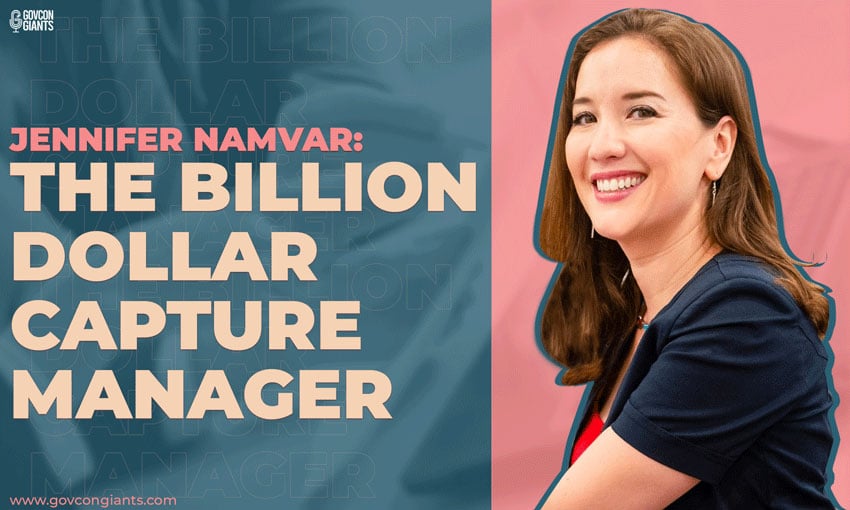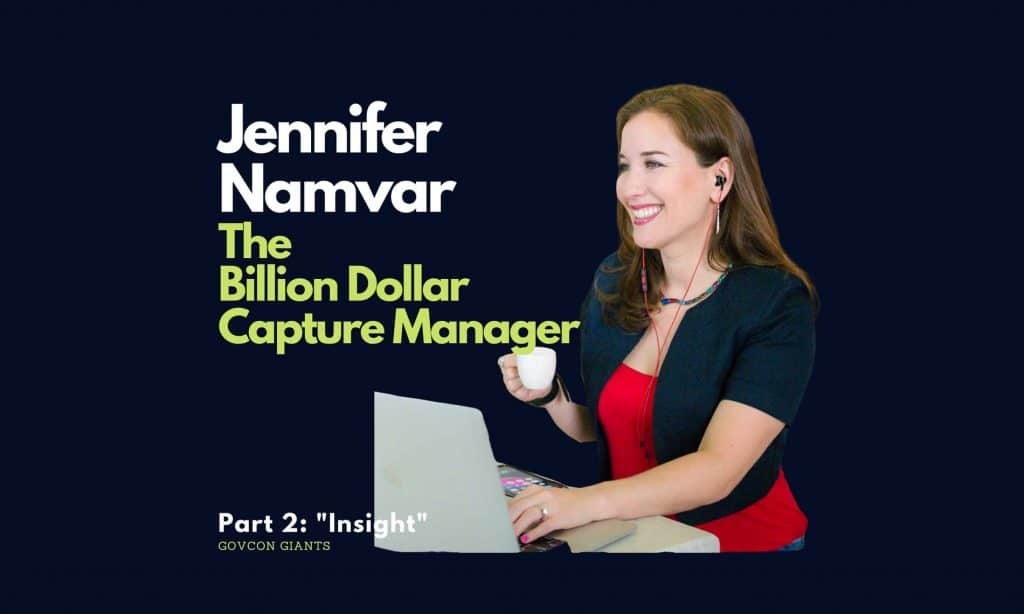With her background as a capture manager, Jennifer Namvar details her work and process and shares her advice for small businesses.
BACKGROUND
Jennifer Namvar has over 15 years of experience in all phases of the federal government business development life cycle.
She built her reputation in the industry through her previous employment with consistent DOD Top 100 list companies including Engility, NCI Information Systems Inc., and CSRA wherein she successfully closed more than $1B in new and re-compete business.
Currently, she is a Capture Director at the IT, engineering, and science solutions and services company, Leidos, and an Advisor at Patri, a software and consulting firm.
Namvar is also providing free content about government contracting on LinkedIn and on her self-named website.
DIFFICULTIES AS A CAPTURE MANAGER
While Namvar is extremely successful in her field, she also experienced difficulties as a capture manager when it comes to team sport. As the manager, she is the leader of the team and she needs to handle everything accordingly as it involves huge amounts of money.
“One of the things is being very clear on the roles and responsibilities. If you’re the capture manager, you need to be the leader, and you have to use different leadership skills. Sometimes you can be collaborative and sometimes you have to be directive.”
Another thing that she has difficulties with was standing up for herself but she soon learned to deal with being firm with her decisions.
“There’s a lot of opinions on how you should do things and you need to take those opinions but you also need to take a stand and be decisive in terms of how you want to go forward with something and be able to back that up.”
Lastly, doing capture takes a very long time and this sometimes requires her to work on evenings and even on weekends. With this, they usually work on a proposal in advance.
PROPOSAL CREATION PROCESS
Namvar recommends that in putting together a proposal, you must outline the requirements and evaluation criteria and then assign each person on your team a responsibility in each part of the proposal.
After that, you can always check up the status of your team. Ensure that they don’t have any questions and if there are some problems, it should be resolved right away.
Then, you can do a review of the draft and the final proposal with key people.
“Get a couple people, either if it’s a startup, sometimes you have a board, sometimes you have business advisors. Get those people to review your proposal. Don’t review your own proposal.”
One crucial thing that you should always consider in this process is the time as the government always assigns a due date to each request.
“You definitely want to give yourself, build in enough time into the schedule so that you don’t have a fail and miss a deadline. Because if you do miss a deadline even by a minute, the government typically will throw you out and you don’t want to waste all that time and money for having a late submission.”
ADVICE FOR SMALL BUSINESSES
1. Have a strategy.
Most small businesses always chase the next shiny object. Rather than doing this, you should have a strategy and build a pipeline to achieve a specific goal.
“It’s interesting because I’ve seen where in particular like 8a firms… If it’s like, say, a metal building, and then, it might be a security job, and then it might be to sell some furniture, but they never really focus on building a business. And so at the end of the day, when the 8a program is over with, they’re left and they don’t have a business and they don’t have relationships and they don’t have customers.”
2. Don’t be afraid.
Everyone has the ability to create art and produce something that is significant to the world. However, if you’re going to be afraid of people’s judgement, how will that benefit you and other people?
“There will be people who don’t like what you put out in the world. They’ll disagree with it, they’ll be jealous, because you’re more successful than the next person. And there’s always going to be… You can’t please everyone all the time. But there are going to be some people out there who really like what you put out there, who really like your company, who have jobs because you created a company. And none of that value would exist if you’re too scared to put it out there.”
3. Nurture your relationship.
Don’t just bid for contracts but focus on nurturing your relationship with decision-makers and clients.
“I think that this is a relationship-based business, and the best thing you can do is number one, nurture a relationship with the decision maker in one of these large businesses and attach yourself at the hip to that person and just constantly, not constantly, but every couple of weeks may be, have lunch with them. Reach out to them. Nurture a relationship with them so that way, you are at the top of their mind when a contractor’s coming out and they need to fulfill a requirement.”
With this, you can find like-minded individuals on networking events or through platforms like LinkedIn.
RESOURCES
If you want to watch the full video of the interview with Jennifer Namvar as she details her work and process as a capture manager and shares her advice for small businesses, then be sure to click the links below:
004: Jennifer Namvar – The Billion Dollar Capture Manager



